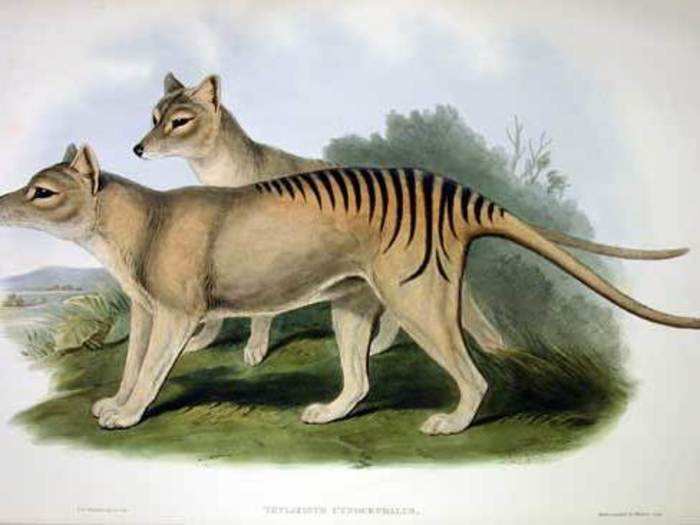
Two years before that, a couple saw an animal that they said they were "100% certain" was a Tasmanian tiger near Corinna, Tasmania.
"The animal had a stiff and firm tail, that was thick at the base. It had stripes down its back," the report read. "It was the size of a large Kelpie (bigger than a fox, smaller than a German Shepherd)."

The government has kept the individuals who filed the reports anonymous.

"It all proved terribly poor value," Nick Mooney, the wildlife biologist currently in charge of the agency's investigations, said in January. "Hundreds and hundreds of times people have gone to look where a sighting report has been, and there's been nothing."
In September 2017, a group called the Booth Richardson Tiger Team made waves by releasing video clips and still images of a creature's blurry snout. The group captured the footage using trail cameras in the Tasmanian wilderness.
"We believe 100% that it is a thylacine," tiger expert Adrian Richardson said during a press conference after releasing videos.
But Mooney was skeptical.
"My first impression was a flash of excitement which sobered on analysis," he told Gizmodo. Optimistically, he said, there was a one in three chance the animal was a Tasmanian tiger.

The creatures were are also known as Tasmanian wolves due to their similarities to dogs, coyotes, and (of course) wolves. A September 2019 study revealed genetic and skeletal similarities between Tasmanian tigers and modern wolves, too.

Unlike most other marsupial species, both male and female Tasmanian tigers had these pouches.
The animal's name, Thylacinus cynocephalus, translates roughly to "dog-headed pouched one."
According to American anthropologist Richard K. Nelson, "The thylacine is, or was, one of the most extraordinary and improbable animals on Earth — a kangaroo redesigned as a wolf."

They could live up to seven years in the wild.

Tasmanian tigers had stiff tails like a kangaroo's, short legs, and jaws with 40 to 50 sharp teeth.

The predators liked to hunt at night, either alone or with a partner.

The tigers communicated via husky, coughing barks or "terrier-like, double yaps," according to the Tasmanian government.

In 1806, Tasmania's surveyor-general described the tiger this way: "Eyes large and full, black, with a nictant membrane, which gives the animal a savage and malicious appearance."

In 1888, Tasmania's government started paying trappers and hunters to kill the creatures.

Before it went extinct, the Tasmanian tiger had been around Australia, Tasmania, and Papua New Guinea for 4 million years.

In May 1930, a farmer named Wilf Batty shot the last wild Tasmanian tiger after he discovered it in his hen house.
Competition from non-native wild dogs and habitat destruction also contributed to the tigers' decline.

The last known Tasmanian tiger, an animal named Benjamin, died at the Beaumaris Zoo in Hobart in September 1936.
Ironically, the Tasmanian government had declared it a protected species just two months prior.

Benjamin's death marked the extinction of the Tasmanian tiger, though it took the government until 1986 to officially declare the species extinct.
Even before that declaration, in the early 1980s, reports of tiger sightings became so frequent that the government started equipping wildlife officials with "Thylacine Response Kits." That way, researchers could properly gather pawprints and scat as evidence of potential sightings, the New Yorker reported,

In 1999, scientists at the Australian Museum started the Thylacine Cloning Project — an attempt to clone a Tasmanian tiger. The research team extracted DNA from female Thylacine tissue that had been preserved in alcohol for more than a century.
But the project was canceled in 2005 after the scientists deemed the DNA unusable.

As recently as 2005, the Australian magazine Bulletin offered a reward of 1.25 million Australian dollars for "a live, uninjured animal."
"Many people are just fascinated with this creature," Greg Berns, a scientist at Emory University, told Smithsonian magazine. "It was iconic."
 6 reasons why you should visit Ladakh this summer
6 reasons why you should visit Ladakh this summer
 TVS iQube gets a new variant priced under ₹1 lakh, ST variant gets a bigger battery
TVS iQube gets a new variant priced under ₹1 lakh, ST variant gets a bigger battery
 As English players begin their premature IPL exodus, Gavaskar calls for action against England Cricket Board
As English players begin their premature IPL exodus, Gavaskar calls for action against England Cricket Board

Copyright © 2024. Times Internet Limited. All rights reserved.For reprint rights. Times Syndication Service.